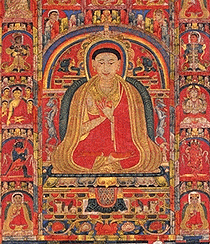This charming thirteenth century portrait depicts a religious hierarch from the Taglung branch of the Kagyu order of Tibetan Buddhism. (Fig. 1, left) Wearing monastic robes, he is seated on a throne whose symbolic significance reflects the considerable spiritual authority which the hierarch enjoyed in his day. Mountain staves, indicating that the central figure is meant to appear within a mountain cave, surround him and his attendants in the upper and side registers. The mountain cave--a sacred site for gods and ascetics with ancient roots in Indian myth--also reveals the high esteem in which the central figure was held by his community. In this portrait, they sought to commemorate the hierarch in a manner commensurate with his accomplishments.
Religious hierarchs were always highly revered in Tibetan society. Lamas (bla-ma), or "superior persons" were important in Tibet even before the introduction of Buddhism, a phenomenon which helps to explain why the Indian notion of religious master (skt., guru) was so easily adapted by Tibetans. King Trisong Detsen (khri-song lde'(u)-btsan, ca. 756-797) required leading religious figures to sit in a position superior to that of his political ministers, on the same level as the king himself. 1 And the Sakya hierarch Phakpa ('phags-pa, 1235-80), First Imperial Preceptor (ch., dishi) to the Yuan rulers, is said to have insisted that his seat be even higher than that of Kubilai Khan. 2
Who is the central figure in this painted portrait? The most likely candidate is the third abbot of Taglung monastery, Sangye Yarjon (1203-72) also known by the Sanskrit name, Prajnaguru. Inscriptions on the reverse of the painting support this interpretation. An inscription along the top in black printed Tibetan script (known as uchen) states that the painting was consecrated by the honorable Onpo Lama Rimpoche of Taglung. (Fig. 2, above) This historical figure is well-known to those familiar with early Tibetan painting because over a dozen paintings consecrated by him and bearing this same inscription have come to light in recent years. Onpo was a disciple of Sangye Yarjon at Taglung monastery. He succeeded his master in 1272, but acted as abbot for only one year. Onpo left Taglung in 1273, and the painting was thus certainly consecrated before this time. Homage is made to Sangye Yarjon, referred to as Prajnaguru, in the longest inscription in red at the center of the painting's reverse, an area roughly corresponding to the central image on the painting obverse.
 |
The thirteenth century portrait in Figure 3, left, features Taglung Thangpa Chenpo (stag-lung thang-pa chen-po, 1142-1210), who in 1180 founded Taglung monastery just north of Lhasa, the seat of his sub-branch of the Kagyu school. Many of the surviving early portraits are associated with the Kagyu school, some specifically with Taglung monastery, a phenomenon which may reflect this monastery's privileged position until very recent times. Around 1476, a leading Tibetan historian wrote that Taglung was the only major monastery to have survived the turmoil of war. 3
Over fifty paintings, datable by inscription to between the late twelfth and the late fourteenth centuries, can be reliably associated with Taglung monastery in Central Tibet. We are extremely fortunate that so many Taglung paintings have survived because in addition to the aesthetic pleasure they afford, as a group they are a rich source of art historical information. Many Taglung paintings are portraits, and approximately one-quarter of all surviving pre-fifteenth century Tibetan paintings are hierarch portraits. The purpose of portraits such as that in Figure 1 is not altogether clear, but some hypotheses can be put forth.
An important fifteenth century Tibetan historical text, The Blue Annals, states that portrait paintings were sometimes made when a great religious figure died and were then distributed to monasteries and chapels frequented by the hierarch. 4 Such portraits may have served both public and private commemorations. Go Lotsawa, author of The Blue Annals, also describes the portrait's function as icon. That portraits could transmit a spiritual presence is suggested by Go Lotsawa's description of Taglung Thangpa Chenpo's introduction to his spiritual master, Phagmodrupa through the latter's portrait. Upon seeing the portrait, Taglung Thangpa Chenpo "felt in himself that he must go and meet his teacher." 5 Some portraits acted as the focus of rituals in which an individual "absorbed" teachings from the painted image. 6 Traditionally, a consecrated painting is the reflection (gzugs-brnyan; skt., pratima or pratibimba) of transcendent spheres, the "physical support" (rten) of a deity. In the final stages of consecration, the officiating monk invites the deity to "inhabit" the work of art. Typical of early Tibetan paintings, most portraits include reverse inscriptions of mantras which mark the forehead, throat, and heart centers (skt., cakra) of the deities and religious figures on the painting's obverse. This aspect of portraiture has yet to be fully examined. 7 However, it is interesting to note that in his religious history, the Second Pawo Rimpoche (1504-66) records the eleventh century Indian Buddhist master Atisa's promise to his Tibetan disciples that after death, he would "come into his own [painted] portrait image." This passage suggests, in this instance, an iconic function for portraiture.
It is likely that the portrait in Figure 1 was created towards the end of the life of Sangye Yarjon or upon his death. Consecrated by his successor, Onpo Lama Rimpoche, it may have been commissioned by another disciple who wished to have a portrait of his master as a reminder of his teachings. It belongs to a growing corpus of early Tibetan paintings which shed light on the aesthetic, religious and social history of pre-fifteenth century Tibet.
commenting on this article

